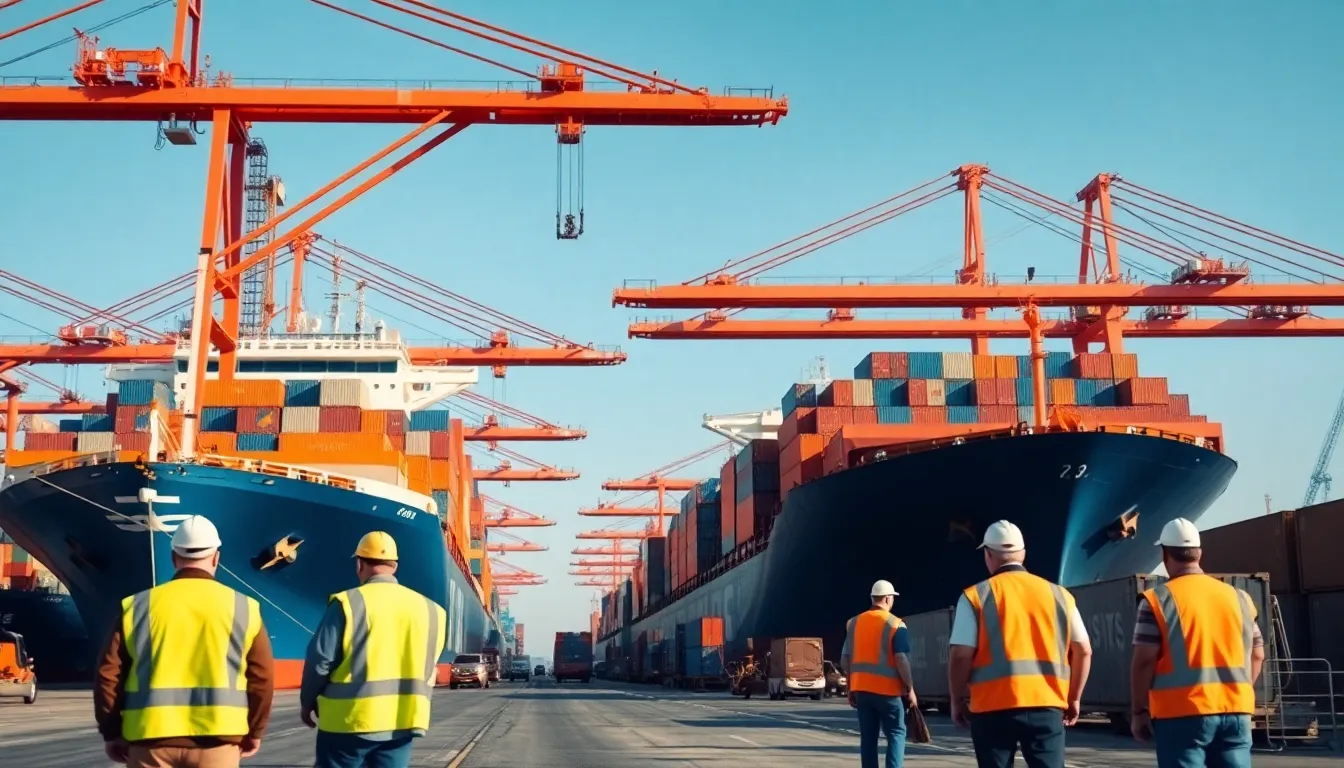Table of Contents
ToggleInternational trade is like the ultimate global buffet where countries swap their finest dishes, from tech gadgets to exotic fruits. It’s not just about buying and selling; it’s a complex dance of economics, politics, and cultural exchange that keeps the world spinning. Ever wondered how your favorite coffee from Colombia ends up in your local café? Or how that sleek smartphone made its way from a factory in China to your pocket?
Overview of International Trade
International trade plays a crucial role in the global economy. This process allows countries to import and export goods, fostering economic growth and stability. Each trading partner contributes to a diverse marketplace that benefits consumers with a variety of products. Regions can specialize in production based on their resources, allowing efficient use of labor and materials. The exchange of goods like agricultural products, electronics, and textiles exemplifies the interconnectedness of economies.
Trade facilitates not only the movement of commodities but also the flow of ideas and technology. Countries collaborate through trade agreements, ensuring mutual economic benefits. These agreements often address tariffs, quotas, and trade rules, strengthening international relationships. For instance, the North American Free Trade Agreement (NAFTA) has accelerated trade among the U.S., Canada, and Mexico, creating a more integrated North American market.
Cultural exchange accompanies this economic interaction. Exposure to foreign goods influences consumer preferences and promotes cultural understanding. Even the journey of a simple item, such as Colombian coffee, highlights how multiple nations contribute to its trade life cycle.
Subsequently, international trade also faces challenges. Trade disputes and protectionist measures can hinder economic benefits. Nonetheless, the overall impact of trade remains positive, driving innovation and competition among nations. With advancements in technology and logistics, global trade continues to evolve, shaping the future of economic relations worldwide.
Benefits of International Trade

International trade presents numerous advantages that significantly impact economies globally. This trade fosters economic expansion and resource accessibility, contributing to greater prosperity.
Economic Growth
Economic growth results from increased trade activities. Countries that engage in international trade experience higher GDP rates, primarily driven by expanded markets and consumer bases. Goods and services become more accessible, allowing businesses to achieve economies of scale. Export-oriented industries, such as technology and agriculture, thrive, driving job creation and income growth. Moreover, diverse competition encourages innovation, forcing companies to enhance products and services. A notable example includes countries like Germany, which has leveraged its exports to become a leading economic power.
Access to Resources
Access to resources enhances production capabilities for nations involved in international trade. Countries often lack specific natural resources needed for manufacturing or agricultural production. By trading, they obtain these vital inputs, strengthening their industries. For instance, Japan imports essential energy sources, while exporting advanced technological goods. This reciprocal relationship supports resource allocation efficiency, enabling nations to focus on sectors where they excel. Accessing global markets fosters resource diversification, reducing vulnerability to local supply chain disruptions. Countries enjoy systematically varied inputs that contribute to overall economic stability.
Challenges in International Trade
International trade encounters multiple challenges that can significantly impact economic relationships. Two critical issues include tariffs and trade barriers, along with political risks affecting trade agreements.
Tariffs and Trade Barriers
Tariffs impose additional costs on imported goods, altering price competitiveness. Countries implement tariffs to protect domestic industries from foreign competition. For example, the U.S. introduced tariffs on steel and aluminum imports, raising prices for manufacturers and consumers. Trade barriers, including quotas and import restrictions, limit the quantity of foreign goods entering a market. Such measures can lead to trade disputes, undermining cooperation between nations. Consequently, businesses must navigate these obstacles carefully to maintain profitability and market access.
Political Risks
Political risks include instability that can disrupt trade flows. Governments may change regulations or withdraw from trade agreements, creating uncertainty for businesses. For instance, Brexit raised concerns about the future of trade between the U.K. and EU, affecting supply chains. Political unrest in a country can lead to sudden export bans or product seizures. Companies engaging in international trade often assess these risks when entering new markets. Adapting strategies to mitigate political influences proves essential for maintaining stable international operations.
The Role of International Trade Agreements
International trade agreements play a vital role in shaping global commerce. They establish the rules governing trade between countries, ensuring smooth exchanges and fostering cooperation.
Bilateral Agreements
Bilateral agreements involve two countries negotiating terms to enhance trade. These agreements typically focus on reducing tariffs, encouraging exports, and safeguarding investments. For example, the U.S. and South Korea implemented a free trade agreement in 2012, leading to significant increases in exports between the two nations. Such arrangements benefit both parties by improving market access and fostering economic ties. Efficiency improves as countries focus on mutually advantageous products, creating competitive advantages.
Multilateral Agreements
Multilateral agreements encompass multiple nations, promoting global trade cooperation. The World Trade Organization (WTO) exemplifies a key multilateral framework, facilitating negotiations on tariffs and trade practices. Agreements like the Comprehensive and Progressive Agreement for Trans-Pacific Partnership (CPTPP) aim to boost trade across the Asia-Pacific region. Countries participating in these agreements witness trade liberalization, increasing market access and economic growth. Collaboration enables nations to address common challenges, enhancing stability and fostering a dynamic global trading system.
Future Trends in International Trade
Emerging technologies will significantly reshape international trade dynamics. Automation and artificial intelligence enhance logistics efficiencies, leading to lower costs. Countries leveraging these technologies can gain competitive advantages in global markets.
E-commerce trends are notable, with online platforms facilitating cross-border trade. Firms increasingly rely on digital solutions to reach wider consumer bases and streamline transactions. As more businesses embrace e-commerce, traditional trade models will evolve.
Sustainability becomes a central focus in trade relations. Companies now prioritize responsible sourcing and ethical production, impacting consumer choices globally. Countries that emphasize sustainable practices may attract environmentally conscious consumers.
Trade agreements continue to adapt to changing geopolitical landscapes. New bilateral and multilateral agreements emerge, reflecting shifts in economic power and priorities. These agreements reshape trading relationships and influence market access.
Digital currencies and blockchain technology see rising interest in international transactions. These innovations promise enhanced security and transparency, fostering greater trust in cross-border exchanges. Nations exploring these technologies may streamline trading processes and reduce fraud.
Regional trading blocs gain prominence, driving economic integration among neighboring countries. Collaborations among regions reinforce collective bargaining power on the global stage. As these blocs expand, their influence on international trade dynamics intensifies.
Supply chain resilience emerges as a critical priority, especially post-pandemic. Businesses strive to diversify supply routes and sources to mitigate risks. Organizations that enhance their supply chain robustness can adapt better to disruptions.
Collaboration between governments and businesses defines future trade policies. They increasingly work together to address challenges and seize opportunities in the global marketplace. Joint efforts can lead to innovative solutions that support sustainable economic growth.
International trade serves as a vital engine for global economic growth and cultural exchange. As nations navigate the complexities of trade agreements and emerging technologies, they unlock new opportunities for innovation and collaboration. The shift towards sustainability and responsible sourcing highlights the evolving priorities of consumers and businesses alike.
While challenges like trade disputes and protectionist measures persist, the overall trajectory of international trade remains positive. Countries that embrace trade can enhance their economic stability and foster deeper connections with global partners. By adapting to changing landscapes and focusing on resilience, nations can continue to thrive in the interconnected world of commerce.




